-
Posts
14,343 -
Joined
-
Last visited
-
Days Won
25
Content Type
Profiles
Forums
Blogs
Gallery
Events
Store
Posts posted by Ed_Haynes
-
-
Padma Shri
Awarded to recognize distinguished service to the nation.
Established: Established in notification No.2-Pres./54 of 2 January 1954, by the President of India. The statutes were revised by No.4-Pres./55 of 8 January 1955 to alter the design remove the class structure and further amended by No.28-Pres./55 of 30 August 1955 (to make provision for a miniature badge of the award) and by No.9-Pres./57 of 26 January 1957 (when the award was further redesigned, as detailed below). Award of the decoration was suspended from 13 July 1977 to 26 January 1980.
General Appearance: The medal a massive circular geometrical badge, 30 mm in diameter.
Obverse: The badge specified in January 1955 was to be a ?mainly circular? 30-mm toned bronze badge with geometrical patterns and, in the center, a lotus flower with five major petals embossed in white gold. Above and below this flower, the name of the decoration ?Padma / Shri? was to be embossed in silver-gilt. In 1957, the badge itself was altered to be of burnished bronze, with all embossing in silver.
Reverse: In the center, the national emblem, with motto below, in silver.
Ribbon: 31 mm, medium pink (?lotus-colored?) with two 6 mm white stripes. Female recipients are authorized to wear the badge from a bow fashioned from this ribbon. Some sources suggest that the initial ribbon for the Padma Vibhushan, Tisra Varg, was to have been a light pink with three narrow white central stripes; ribbons in such design exist in some collections. Since 1981, a darker pink has been used for the Padma Shri ribbon and the ribbon has had corded edges. While no documentation for these ribbon alterations has been found, the shifts in ribbon colour are supported by observation of specimens.
Suspension: The badge is suspended by a ring.
Naming: The award is unnamed.
Miniature: A miniature was provided for in 1957.
Representative Citation: To understand the award better, a sample recipient would be the award of 26 January 1971 to Dr Harbhajan Singh, Head of the Plant Introduction Division, Indian Agricultural Research Institute, New Delhi. (No.8-Pres./71 of 26 January 1971):
?Dr. Harbhajan Singh (55) has conducted intensive research in Plant Breeding, Plant Genetics and Taxonomy and evolved a number of high yielding varieties of vegetables. He has arranged the systematic collection and dissemination of richly diverse germ plasm from exotic and indigenous sources for a wide variety of agri-horti-sylvi-cultural plants under phytosanitary conditions. Plant Breeders the world over, and those of India in particular have benefited from this activity. In the field of plant exploration he has carried out one-man trips and has also led teams of agricultural plant explorers, to different parts of India and neighbouring countries. This has helped in the collection of wide germ plasm comprising primitive and obsolete cultivation of many crop plants as well as of their wild relatives, which is a major contribution to the important task of stemming genetic erosion.
?He played a leading role in the breeding an d selection of nearly 40 varieties of field crops and vegetables several of which are of all-India importance. As Head of the Division of Plant Introduction, Indian Agricultural Research Institute, he has played an active part in the establishment and organisation of the National Plant Introduction Service. He has published 120 scientific, technical and popular articles including monographs, bulletins, research reviews and others relating to agri-horticultural plants.?
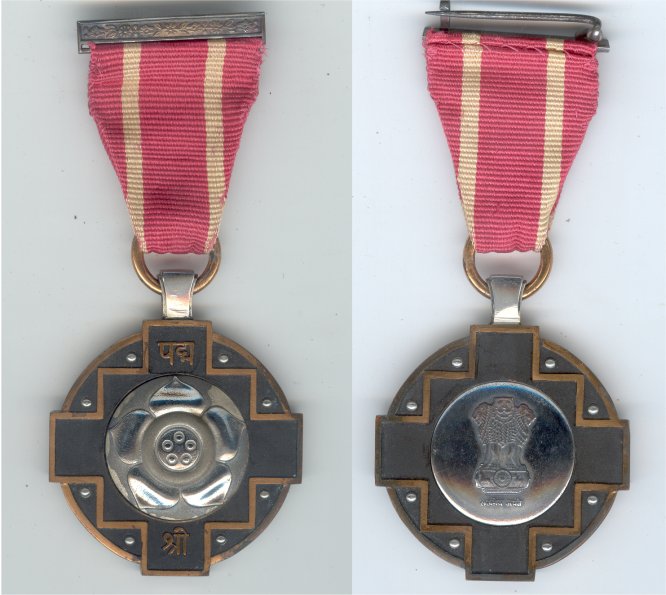
 0
0 -
Padma Bhushan
Awarded to recognize distinguished service to the nation of a high order.
Established: Established in notification No.2-Pres./54 of 2 January 1954, by the President of India. The statutes were revised by No.3-Pres./55 of 8 January 1955 to alter the design and to remove the class structure and further amended by No.27-Pres./55 of 30 August 1955 (to make provision for a miniature badge of the award) and by No.8-Pres./57 of 26 January 1957 (when the award was further redesigned, as detailed below). Award of the decoration was suspended from 13 July 1977 to 26 January 1980.
General Appearance: The medal a massive circular geometrical badge, 30 mm in diameter.
Obverse: The badge specified in January 1955 was to be a ?mainly circular? 30-mm toned bronze badge with geometrical patterns and, in the center, a lotus flower with three major petals embossed in silver gilt. Above and below this flower, the name of the decoration ?Padma / Bhushan? was to be embossed in silver-gilt. In 1957, the badge itself was altered to be of burnished bronze, with all embossing in silver gilt.
Reverse: In the center, the national emblem, with motto below, in silver gilt.
Ribbon: 32 mm, medium pink (officially, ?lotus-colored?) with a 6 mm central white stripe. (Medium pink 13 mm, white 6 mm, medium pink 13 mm.) Female recipients are authorized to wear the badge from a bow fashioned from this ribbon. Some sources suggest that the initial ribbon for the Padma Vibhushan, Dusra Varg, was to have been a light pink with two narrow white central stripes; ribbons in such design exist in some collections. Since 1981, a darker pink has been used for the Padma Bhushan ribbon and the ribbon has had corded edges. While no documentation for these ribbon alterations has been found, the shifts in ribbon colour are supported by observation of specimens. All badges are awarded with a silver gilt floriated brooch bar.
Suspension: The badge is suspended by a fixed, non-swiveling ring.
Naming: The medal is unnamed.
Miniature: A miniature with brooch bar was provided for in 1957.
Representative Citation: To understand the award better, a sample recipient would be that awarded 26 January 1963 to Ramanlal Gokaldas Saraiya:
"A pioneer in the field of cooperative Sri Ramanlal Gokaldas Saraiya has rendered valuable cooperation to develop the cooperative movement in India. He has been Chairman and Vice-Chairman of many State and All-India level organisations like Bombay State Cooperative Bank, All India Cooperative Organisation, National Development and Storage Board, etc.
"Shri Saraiya is a member of many important Commerce Organisations of the country. In 1953-54 he was Chairman of the Federation of Indian Chamber of Commerce and Industry and a Director of Reserve Bank of India and Indian Insurance Corporation.
"Shri Saraiya is Chairman of Maharashtra State Road Transport Corporation since 1954. Under his skillful supervision the Corporation has made a big progress and now it is thought that among the Public Sector Undertakings its management is the best."
He had also been awarded the OBE in 1941.
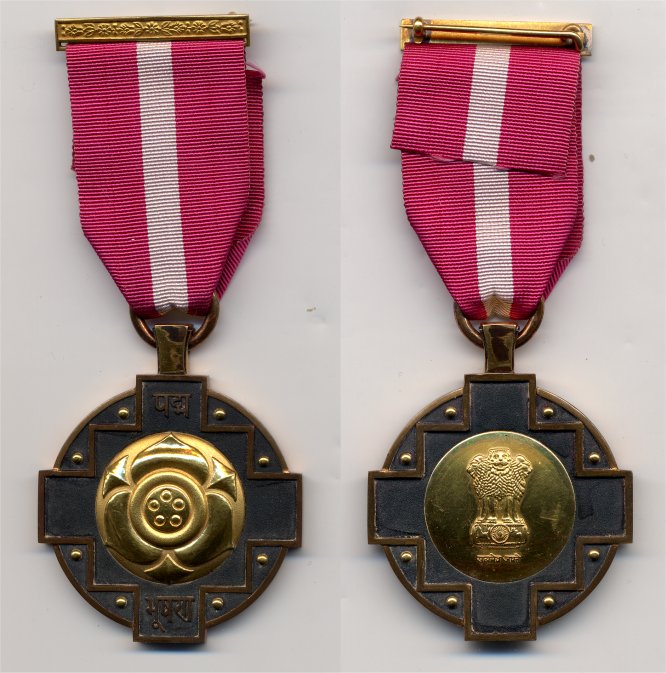
 0
0 -
Padma Vibhushan
Awarded to recognize exceptional and distinguished service to the nation.
Established: Established by notification No.2-Pres./54 of 2 January 1954, by the President of India. The statutes were revised by No.2-Pres./55 of 8 January 1955 to redesign the badge and remove the class structure and further amended by No.26-Pres./55 of 30 August 1955 (to make provision for a miniature badge of the award) and No.7-Pres./57 of 26 January 1957 (when the award was further redesigned, as detailed below). Award of the decoration was suspended from 13 July 1977 to 26 January 1980 (No.65-Pres./77 and No.25-Pres./80).
General Appearance: The medal a massive circular geometrical badge, 30 mm in diameter.
Obverse: The badge specified in January 1955 was to be a ?mainly circular? 30-mm toned bronze badge with geometrical patterns and, in the center, a lotus flower with four major petals embossed in white gold. Above and below this flower, the name of the decoration ?Padma / Vibhushan? was to be embossed in silver-gilt. In 1957, the badge itself was altered to be of burnished bronze, with all embossing in white gold.
Reverse: In the center, the national emblem with motto below, in white gold.
Ribbon: 32 mm, lotus pink. Female recipients are authorized to wear the badge from a bow fashioned from this ribbon. Some sources suggest that the initial ribbon for the Padma Vibhushan, Pahela Varg, was to have been a light pink with a single narrow white central stripe; ribbons in such design exist in some collections. Since 1981, a darker pink has been used for the Padma Vibhushan ribbon and the ribbon has had corded edges. While no documentation for these ribbon alterations has been found, the shifts in ribbon colour are supported by observation of specimens. All badges are awarded with a silver floriated brooch bar.
Suspension: The badge is suspended by a fixed, non-swiveling ring.
Naming: There is no naming.
Miniature: A miniature with brooch bar was provided for in 1957.
Representative Citation: To understand the award better, a sample recipient would be that to the Air Chief Marshal Om Prakash Mehra, Indian Air Force, awarded 26 January 1977:
?Former Chief of the Air Staff, Air Chief Marshal Om Prakash Mehra, served the Indian Air Force with distinction. Born on 19-1-1919, he joined the IAFVR on 30th November 1940 as a Commissioned Officer. He served in the North West Frontier and in Burma-Arakan Coast with No. 3 Squadron. In 1946 he served as representative of the Indian Air Force with the Indian defence contingent of the Joint Chiefs of Staff in Australia, an organization representing Britain, Australia, New Zealand and India which was responsible for the control of elements/formations of the defence services of these countries in Japan.
?In 1947 he took over command of the Flying Training School at Jodhpur. In the Air Force, he held various posts, including Director of Training, Senior Air Officer of Operational Group, Commander Armament Training Wing and Air Officer-in-Charge Policy and Plans at Air HQ. He served as Dean of the Institute of Armament Technology for 3 Years. He was appointed Deputy Chief of the Air Staff in 1969. In January 1971 he was selected as Chairman, Hindustan Aeronautics Limited, Bangalore. He took over as Chief of the Air Staff on 15th January, 1973 and relinquished the appointment on 31st January, 1976, on retirement.
?Air Chief Marshal Mehra was awarded the Param Vishisht Seva Medal in 1968. Being deeply interested in sports and physical education, he is currently the President of the National Indian Olympic Association and is a member of the Board of Governors of the Society for the National Institutes of Physical Education and Sports.?
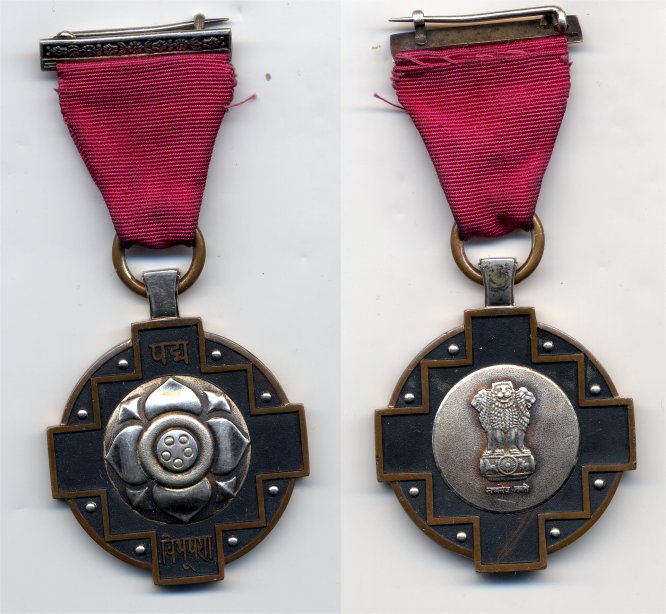
 0
0 -
Bet you haven't seen THIS!
To personnel of the National Security Guards who took part in ?Operation Black Thunder? in the Punjab in 1988.
We believe only four were ever made, and never issued. For obvious reasons?

 0
0 -
Well, it is a civilian medal. Intended for "reconstruction" services. The military have their medal already, with as many clasps as it needs?
0 -
I think you have us all thinking, looking, searching, puzzling.
0 -
Yes, what I cite (the PDF) is the official approval.
0 -
I would HOPE these wouldn't classify as a new variation, just as "noise" in the manufacturing process.
0 -
Well, a lot of the badges that have recently come to market are flush-outs from the valuts of the state bank. (Like almost everything else seen in the last couple of years.)
Late issues or replacement documents? Could be either. Shall try to find out.
I still think the FAKES coming out of China are just that.
0 -
OK, to quote:
The cuneiform symbols on the reverse of the medal can be roughly translated as ?land bringing forth life?. The depiction of the two rivers is based on relief carving from Mesopotamia, to be found in the British Museum.Well, this is based on plundered national treasure of Iraq too, but not as bad as the regular campaign medal.
0 -
Ribbons not bad. Herself doesn't look too pleased, though. And assuming that the reverse symbolizes the parallel flow of the Tigris and Euphrates, WHAT is the slab of CHEESE in the middle supposed to be?

(I liked the "old fashioned" ones with bare-breasted sphynxes and winged lions and Britannia lolling about tangled in gear. Gave you something to LOOK at....)
Ribbon soooo close to UNEF.
Better than her wearing her Clown Crown?
As explained in the notification (the PDF file), the central legenmd is an inspirational message in Cuneiform. Again, better than stolen Iraqi national treasures?
0 -
A not very nice image, but:

 1
1 -
Nice Order of the Red Banner for Military Valor in the background...

Ch.
Oh yesss. Wish we could see what our young lieutenant wears.
0 -
It is a PDF file, Paul. You need the (free) Adobe Acrobat reader to see it.
0 -
And a closeup of the lieutenant (?). Who was he??

 0
0 -
Interestingly, these seem to have been issued to award recipients, for this is the front.
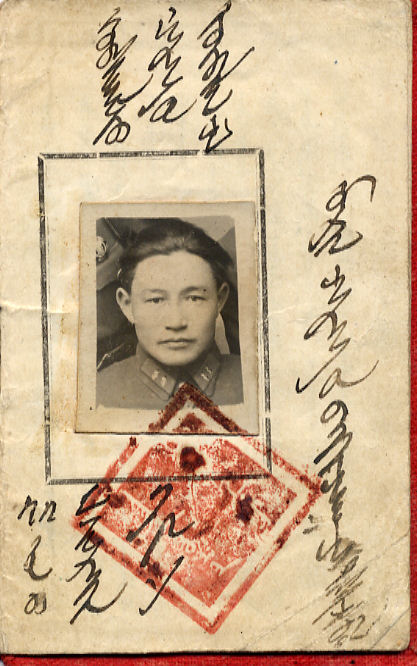
 0
0 -
It is, of course, in bichig. A sample page (the first). Rather than post the text, I'll try to get a translation.
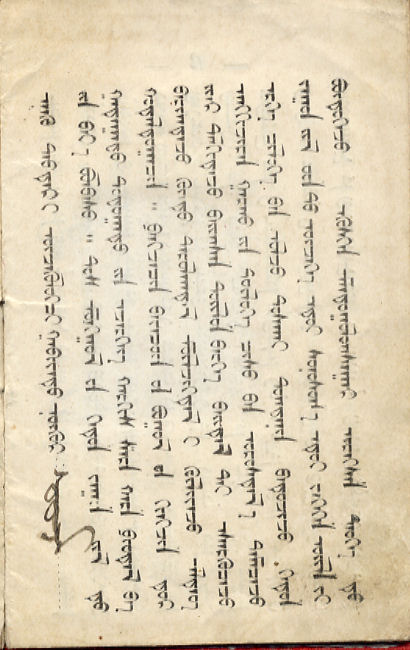
 0
0 -
As shown on Battushig's book on p. 26, this is the little cloth-covered booklet, 17 pages only, of the 1931 awards rules.

 0
0 -
And his awards:
Order of Combat Valor, #14, 6 July 1946
Honorary Medal of Combat, #902, 10 July 1941
Polar Star, #1029, 29 September 1945
Honorary Medal of Combat, #7622, 8 July 1947
Polar Star, #2824, 5 February 1949
Polar Star, #5941, 24 July 1948
Order of Combat Valor, #391, 11 September 1953

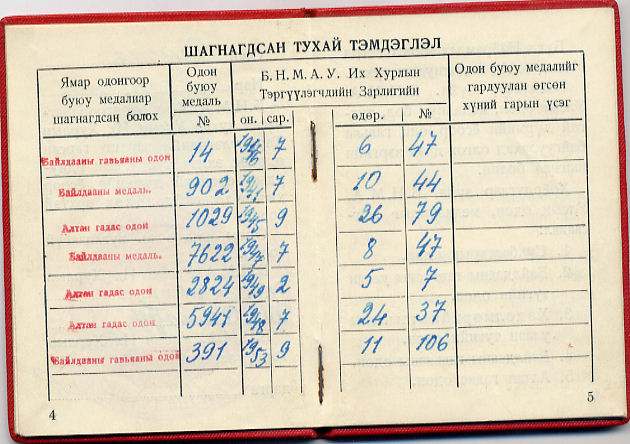
 0
0 -
Closeup of the prominent- and powerful-looking recipient.

 0
0 -
The next spread.

 0
0 -
First page. 9 July 1946 document.
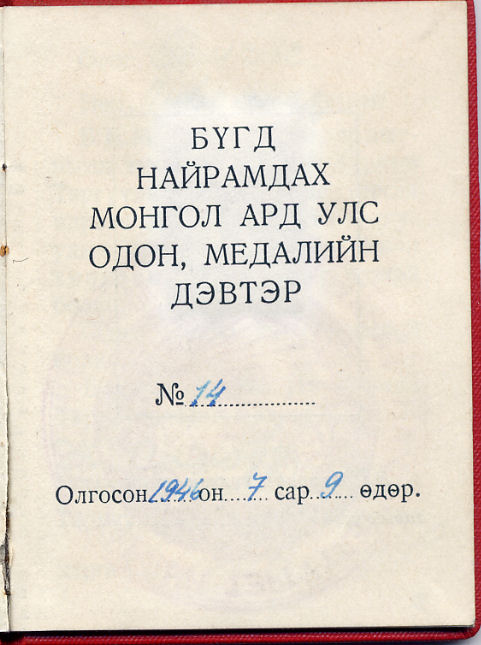
 0
0 -
One more.
Exterior.

 0
0 -
Much to know, much to learn . . . ??

 0
0




INDIA -- Garaj Star
in South Asia
Posted · Edited by Ed_Haynes
Reverse - Blank, presumably intended for naming.
To quote from a forthcoming book
As I said, only four specimens were ever made, and the medal was never awarded. But the ribbon is seen in ribbon bars. For example: